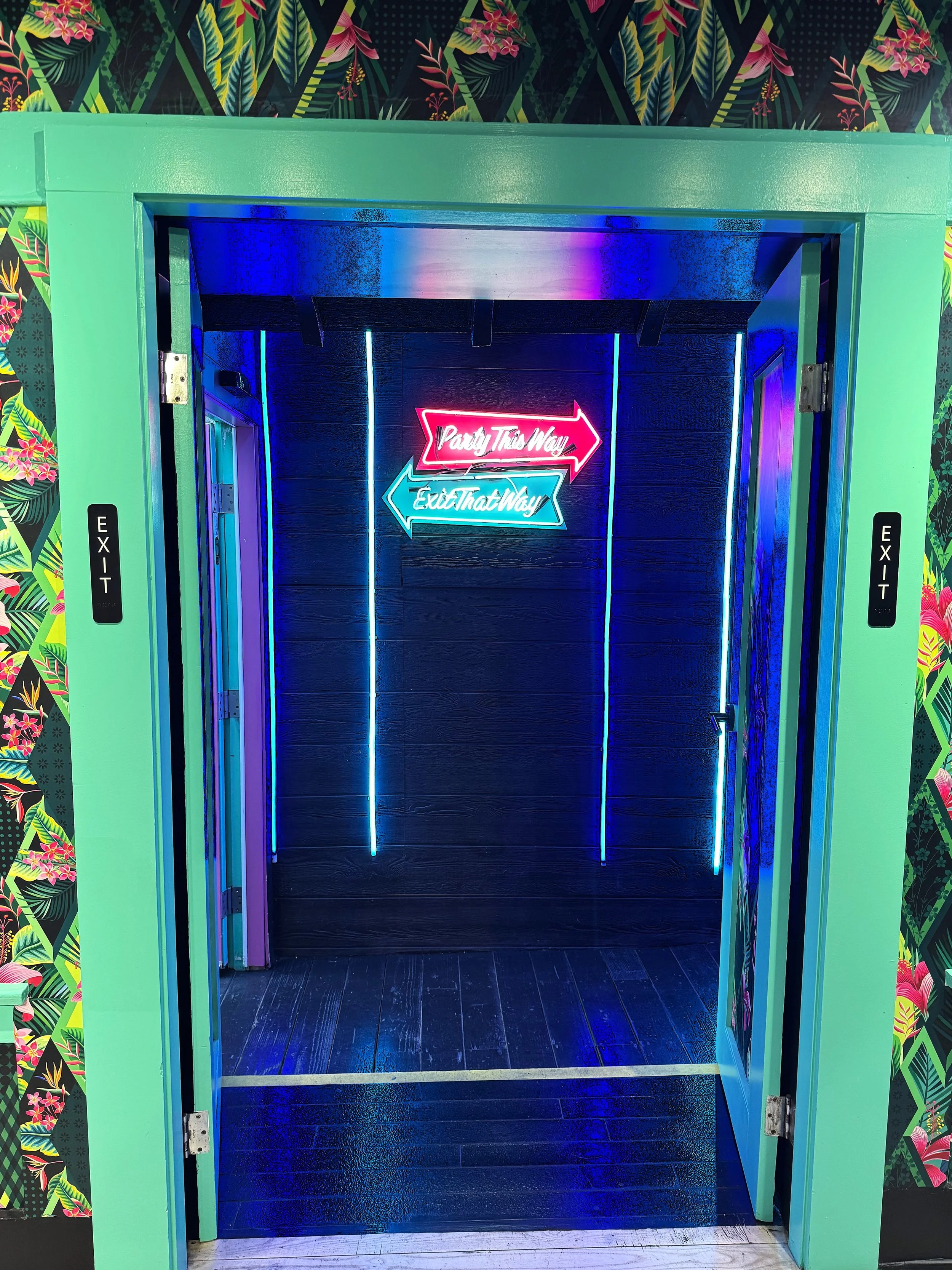How to Up Customer Engagement in Your Retail Space.
Retail is quickly transforming. Stores used to simply be transactional, but in today’s landscape where products are a click away, people are craving more than just shelves stocked with products when they leave their homes. Customers are looking for experiences and connections from the moment they walk into your retail space to the moment they leave. If your shop doesn’t deliver, they will quickly find somewhere else that does.
This is why retail customer engagement is at the core of our design process. Whether you’re building from scratch or refreshing an existing space, thoughtful design choices can dramatically increase retail customer engagement, which in turn leads to an increase in sales revenue, dollars per transaction, and conversion rates. In this article, we’ll explore strategies to what retail customer engagement is, why it matters, and how to increase it inside your store.
HOKA Michigan Ave Chicago (April 2025). HOKA includes an interactive “Find Your Fit” machine to invite customer engagement.
What Is Retail Customer Engagement?
Retail customer engagement is the process by which brands interact with customers to strengthen their relationship. In a retail setting, it is all about how customers interact with your space, your products, and your brand on a deeper level. Whether that’s pausing to read a story on your wall, trying out a product sample, or attending a community event in-store, engagement turns passive browsing into an active experience. The more engaged your customers are, the more likely they are to return, make a purchase, and share their experience with others.
Why Is Retail Customer Engagement Important?
Engaged customers spend more time in your store, form stronger emotional connections with your brand, and are far more likely to make a purchase and come back again. Retail customer engagement leads to trust, and trust builds loyalty. It also drives word-of-mouth, social sharing, and long-term growth. With more brands competing for attention than ever before, creating an in-store experience that captures interest and encourages interaction isn’t a nice-to-have; it’s a business strategy.
How to Boost Retail Customer Engagement
Add a Seating or Community Area
One of the simplest ways to increase retail customer engagement is by giving users permission to slow down. A well-placed seating area invites people to linger without expectations of a purchase. Whether they’re waiting for someone in the fitting room, scrolling through inspiration, or just taking a break, the longer someone stays in your space, the more connected they feel to your brand.
A Path Intelligence study from 2007 involving a shopping center in the UK found that sales can increase 1.3% by increasing dwell time by 1%. These areas can take many forms. From a full-on community space with workshops to a simple seating area that consists of a cozy bench and side table, these moments of pause create room for curiosity, conversation, and deeper brand interaction.
Faherty Portland on 23rd Ave (April 2024). Faherty’s seating area invites customers to relax and stay awhile.
Rivian Seattle University Village (April 2024). Rivian’s large community area creates a sense of belonging.
Create Storytelling Elements to Connect with Your Brand’s Deeper Values
Today’s customers want to feel good about the brands and companies they support with their hard-earned money. This means people are more likely to purchase from and connect with brands that stand for something.
Storytelling elements transform retail spaces from a place that sells products into a space that shares a purpose. Through signage, POP displays, visual merchandising, materials, and messaging, you can tell stories about your brand’s values, origin, sustainability efforts, or product innovation. These elements invite customers to understand and connect with the “why” behind your brand, not just the “what.” Leaning into emotional connections builds trust, loyalty, and long-term retail customer engagement.
Kuhl Park City (June 2024). Kuhl shares it’s purpose statement before you can even enter their store.
Roark Park City (June 2024). Roark’s mission statement helps the brand connect with customers without human interaction.
Incorporate Localized Elements to Build Community Connection
Thoughtful, localized details make retail spaces feel relevant and authentic, giving both locals and visitors a reason to connect with the space on a deeper level. City-specific artwork, neighborhood references, or regionally inspired product stories all create a sense of familiarity and belonging and signal that the brand is truly invested in the community it’s located in.
HOKA Michigan Ave Chicago (April 2025). This custom artwork cements HOKA’s location in the community.
North Face University Village Seattle (April 2024). North Face’s map includes outdoor activities to share what’s available in the community.
Encourage Touch and Interaction with Tactile Displays
Tactile displays invite customers to touch, feel, and explore products in a hands-on way, turning passive browsing into active engagement. In the outdoor and apparel space especially, customers want to experience the texture of a fabric, the structure of a boot, or the flexibility of a backpack strap before they commit. Incorporating touchable elements creates a sense of trust and curiosity, as well as getting customers to start imagining how certain products actually fit into their lives.
Doc Martens Portland (April 2024). Doc Martens display shares the materials used inside their products.
Apple Seattle University Village (April 2024).
Use Multi-Sided Displays to Invite Exploration
Multi-sided displays are a powerful way to encourage movement and discovery within your store. Unlike flat walls or one-sided shelving, these fixtures are designed to be approached from multiple angles, inviting customers to walk around, engage with different products, and naturally explore the space. Multi-sided displays create visual interest from every direction and help guide the flow of traffic without feeling forced. Whether used for seasonal stories, new arrivals, or curated product collections, multi-sided displays encourage curiosity and interaction, turning a quick visit into a longer, more immersive experience.
HOKA Abbot Kinney (December 2024). HOKA’s footwear pedestal is multi-sided to draw in customers.
On Portland (April 2024). On’s huge display engages users to walk around and interact with product.
Lean into Unexpected Elements
Memorable spaces go beyond beautiful fixtures and well-placed products, they lean into the unexpected. Whether it’s a unique use of materials, an unexpected layout, or playful design details, these moments of discovery transform the store from a place to shop into an experience to enjoy. Unexpected touches not only differentiate each space but also deepen the emotional connection between the brand and the customer.
Goodr Abbot Kinney (December 2024). Goodr creates curiosity with lights and hallways.
Goodr Abbot Kinney (December 2024). Goodr’s unexpected areas invite users to explore.
Final Thoughts on Boosting Your Retail Customer Engagement
Retail customer engagement doesn’t happen by accident, it’s the result of intentional, thoughtful design. From seating areas that invite people to linger to tactile displays and localized details that spark emotional connection, every element in your retail space should serve a purpose beyond just holding product.
When you create a space that encourages exploration, interaction, and connection, you’re not just selling, you’re building loyalty, community, and a reason for customers to keep coming back.
How to Incorporate These Strategies to Increase Retail Customer Engagement
Now that you understand the strategies to increase retail customer engagement, it’s time to integrate these into your space. With over 15 years of architecture, in-house brand, and design agency experience for influential brands including HOKA, Arc’teryx, Nike, Adidas, and Garmin, Feels on Brand is the go-to retail experience design studio for creating unforgettable retail spaces. Together, we'll help navigate designing and implementing your next retail brand experience.
Learn more about how our team will bring your vision to life through our key services and how to get started reserving your project timeline on our planning page.















